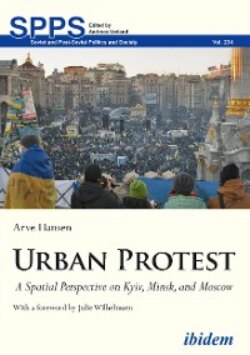Читать книгу Urban Protest - Arve Hansen - Страница 18
2000s
ОглавлениеFollowing a somewhat chaotic decade in the 1990s,6 a new wave of social movements and mass protests hit the Balkans, Eastern Europe, and Central Asia in the 2000s (see fig. 5). Inspired by the Eastern European protests of the late 1980s, the demonstrators used nonviolent means to occupy central public squares in capital cities. The protests were often triggered by election fraud, and they demanded (and often achieved) the resignation of the elites that had managed to hold on to power after the breakup of the Eastern Bloc. The social movements of the 2000s are usually known as colour revolutions, with reference to the bright colours and symbols employed by the protesters. Although not in the former Soviet Union, the Yugoslavian Bulldozer Revolution, which overthrew President Slobodan Milošević in 2000, is often regarded as the first of the colour revolutions (e.g. by Tucker 2005).
Figure 5: Notable protests and colour revolutions in post-Soviet states in the 2000s
| Year | Country | Focal point | Name(s) | Result |
| 2003 | Georgia | In front of the Parliament (Tbilisi) | Rose Revolution | Resignation of President Shevardnadze, new parliamentary elections. |
| 2003–2004 | Armenia | Freedom Square (Yerevan) | 2003–2004 Armenian Protests | Forceful removal of protesters, legal retributions against protesters and protest organisers. |
| 2004–2005 | Ukraine | Maidan (Kyiv) | Orange Revolution | New presidential elections. |
| 2005 | Kyrgyzstan | Ala-Too Square (Bishkek) | Tulip Revolution | Resignation of President Akayev, new presidential elections. |
| 2005 | Azerbaijan | Gelebe/Galaba Square (Baku) | 2005 Azerbaijani Protests | Some concessions. “[O]fficial results for 7 or 8 of 125 parliamentary seats [were] annulled.” (Chivers 2005) |
| 2006 | Belarus | October Square (Minsk) | Kalinowskyi Square/Jeans Revolution | Forceful removal of the protest camp, legal retributions against protesters and protest organisers. |
| 2008 | Armenia | Freedom Square (Yerevan) | 2008 Armenian Protests | Forceful removal of the protest camp, protesters killed, legal retributions against protesters and protest organisers. |
| 2009 | Moldova | Great National Assembly Square (Chișinău) | Twitter Revolution | New parliamentary elections, resignation of President Voronin. |
The above three categories (form, motivation, waves) are not intended to be exhaustive, but to illustrate that “urban contention” is a multifaceted term with historic and contemporary relevance to most regions in the world. The following section serves two purposes: 1) to provide a justification for choosing Kyiv, Minsk, and Moscow as case studies for the three articles in this study; and 2) to show that space and protests are important factors which have affected, and continue to affect, the political situation in the East Slavic area.
